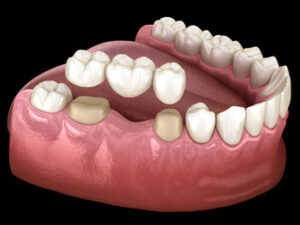A missing tooth can affect more than just your smile—it can interfere with your ability to chew, speak clearly, and uphold good oral health. Whether tooth loss results from decay, injury, or disease, a dental bridge provides a natural-looking solution to restore both function and appearance. But what does the journey look like before and after dental bridge procedure? Let’s dive into the transformation process and explore the various types of bridges that can help replace missing teeth.
Before Getting a Dental Bridge: What You Need to Know
A dental bridge is a trusted and effective method to replace missing teeth, restoring both function and aesthetics. However, before committing to this natural-looking solution, it’s essential to understand the preparation process, the types of bridges available, and what to expect. Knowing these details can help you make a proper decision about your oral health and ensure the best possible outcome.
Assessing Your Needs
Before you choose a new dental bridge, your dentist will review your oral health to determine whether you are a good candidate. This involves checking the condition of your adjacent teeth, gums, and jawbone structure. In many instances, additional treatments, such as dental crowns or implants, may be required for better support.
 Choosing the Right Type of Bridge
Choosing the Right Type of Bridge
There are several types of bridges designed to accommodate different patient needs:
- Traditional Bridges – These rely on abutment teeth (natural teeth adjacent to the gap) for support.
- Implant-Supported Bridges – Rather than depending on natural teeth for support, these bridges are secured using dental implants that are surgically fixed into the jawbone for enhanced stability.
The Preparation Process
Once the type of bridge is determined, the procedure involves reshaping the abutment teeth to create space for the final bridge. A temporary bridge is usually placed while a permanent restoration is fabricated at a dental lab.
The Transformation: What Happens After a Dental Bridge?
Getting a dental bridge is a significant step toward restoring your smile and oral health. Once the final bridge is placed, patients experience noticeable improvements in their ability to confidently chew, speak, and smile. However, adjusting to a new dental bridge takes time, and knowing what to expect can help ease the transition. Let’s explore the immediate changes, adaptation process, and long-term benefits of a dental bridge.
Immediate Changes
Once the final bridge is secured, patients notice immediate improvements in their ability to chew, speak, and smile with confidence. The bridge integrates seamlessly with the natural teeth, making it a natural-looking solution for missing teeth.
Adapting to the New Dental Bridge
It may take a few days to adjust to your new dental bridge, but soon, it will feel like a natural part of your mouth. Some common adjustments include:
- Increased chewing efficiency
- Improved speech clarity
- A more balanced bite to prevent strain on other teeth
Long-Term Benefits
A well-maintained porcelain bridge or implant-supported bridge can last for over a decade, providing strength, stability, and improved oral health. Patients can confidently showcase their smile gallery transformation, knowing their new teeth look and function just like real ones.
Dental Bridge vs. Dental Implants: Which One is Right for You?
Both dental implants and bridges are effective solutions for replacing a missing tooth, but they work differently:
- Dental Implants: Involve a surgical procedure to place a titanium post into the jawbone, creating a durable and self-supporting solution for replacing a missing tooth.
- Dental Bridges: Depend on surrounding teeth for support and may be preferred for patients who do not want implant surgery.
The right choice relies on your oral health, jawbone strength, and personal preferences. Your dentist will guide you through the best treatment plan during your appointment.
Caring for Your Dental Bridge: Maintaining Long-Lasting Results
A dental bridge is a valuable addition to your oral health, and with the right care, it can remain durable for years. Practising good hygiene and adhering to your dentist’s advice can help prevent issues and extend the lifespan of your new dental bridge.
Daily Oral Hygiene
Keeping your dental bridge clean is essential to prevent decay and gum disease. Follow these tips to preserve a healthy smile:
- Brush and floss daily: Use a soft-bristled toothbrush and non-abrasive toothpaste to clean your crowns and bridges.
- Use a floss threader or interdental brush: These tools help clean beneath the artificial teeth and around the abutment teeth.
- Rinse with an antibacterial mouthwash: Helps maintain healthy gums and reduces plaque buildup.
Regular Office Visits
Routine office visits allow your dentist to monitor the condition of your dental bridge and check for early signs of wear, decay, or gum disease. Professional cleanings help keep both your natural teeth and bridge in top condition.
Dietary Considerations

- Steer clear of sticky or hard foods, as they can potentially loosen or harm the final bridge.
- Cut crunchy foods into smaller pieces to reduce pressure on the surrounding teeth.
- Limit sugary foods to prevent plaque buildup around the abutment teeth.
By adhering to these care guidelines, your dental bridge will stay durable and natural-looking, effectively replacing your missing tooth and helping you maintain a confident, healthy smile for years.
Final Thoughts: A Confident Smile with Dental Bridges
The transformation before and after a dental bridge is remarkable. Whether replacing front teeth or back teeth, these restorations provide a durable and natural-looking solution to improve both function and aesthetics. If you’re considering a new dental bridge, book an appointment with Dental 266 at 02 9051 0600 to explore your options and achieve the healthy smile you’ve always wanted.
Note: Any surgical or invasive procedure carries risks. Before proceeding, you should seek a second opinion from an appropriately qualified health practitioner.
References
Cleveland Clinic. (n.d.). Dental implants. Retrieved from https://my.clevelandclinic.org/health/treatments/10903-dental-implants
WebMD. (n.d.). Dental health: Bridges. Retrieved from https://www.webmd.com/oral-health/dental-health-bridges
National Institute of Dental and Craniofacial Research. (n.d.). Oral hygiene. Retrieved from https://www.nidcr.nih.gov/health-info/oral-hygiene


 Choosing the Right Type of Bridge
Choosing the Right Type of Bridge



